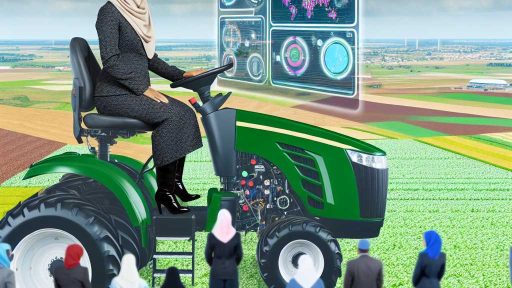Introduction to Key Legal Changes in Agriculture
The agricultural sector is currently undergoing significant legal transformations.
These changes affect farmers, landowners, and agricultural businesses.
Understanding these legal modifications is essential for compliance and success.
This section explores key legislative updates impacting the agriculture industry.
Emerging Agricultural Laws
Recently, several new laws have been enacted to support sustainable farming practices.
These laws aim to mitigate environmental impacts and promote resource conservation.
For instance, regulations now incentivize the use of eco-friendly technologies.
To illustrate, the Green Farming Act provides tax credits for conservation efforts.
Climate Change Legislation
Climate change is a pressing issue affecting agricultural operations.
The government has introduced legislation addressing climate-related challenges.
These laws guide farmers in implementing resilient strategies against climate impacts.
Moreover, federal programs provide financial assistance for sustainable practices.
Labor Law Revisions
Recent revisions to labor laws significantly influence agricultural workers’ rights.
These changes expand benefits and protections for farmworkers across the nation.
Compliance with labor standards is now more critical for employers in agriculture.
Transform Your Agribusiness
Unlock your farm's potential with expert advice tailored to your needs. Get actionable steps that drive real results.
Get StartedStrict penalties apply to those who fail to adhere to the updated regulations.
Trade Policy Changes
Trade policies also evolve to reflect new economic realities.
These adjustments can directly affect export opportunities for farmers.
Changes in tariff rates influence market access for agricultural products.
Consequently, understanding trade agreements is essential for strategic planning.
Regulatory Compliance Requirements
Compliance with governmental regulations is more important than ever.
Farmers must navigate a complex landscape of local, state, and federal rules.
Penalties for non-compliance can be severe, affecting business viability.
Staying informed about regulatory updates is crucial for all agricultural stakeholders.
Impact of Environmental Regulations on Farming Practices
Overview of Environmental Regulations
Environmental regulations aim to protect natural resources.
These laws impact various agricultural practices today.
Policies cover water usage, pesticide application, and soil conservation.
Complying with regulations can be challenging for farmers.
Effects on Water Usage
Many regulations limit water consumption during drought periods.
Farmers must adapt irrigation systems to conserve water.
Drip irrigation methods have gained popularity as a result.
Moreover, sustainable water practices enhance crop yield.
Farmers benefit from healthier ecosystems through responsible water use.
Pesticide Application Restrictions
Regulations often restrict the types of pesticides farmers can use.
Many chemicals are banned due to their environmental impacts.
Farmers must seek alternative pest control methods.
Integrated pest management (IPM) offers effective solutions.
IPM reduces chemical use while maintaining crop health.
Soil Conservation Practices
Soil conservation regulations promote sustainable farming techniques.
Showcase Your Farming Business
Publish your professional farming services profile on our blog for a one-time fee of $200 and reach a dedicated audience of farmers and agribusiness owners.
Publish Your ProfileThese practices prevent erosion and improve soil quality.
Cover cropping and reduced tillage are commonly encouraged.
Implementing these techniques can boost farm productivity.
Healthy soil is essential for long-term agricultural success.
Economic Implications for Farmers
Compliance with regulations often incurs additional costs.
Investing in new technologies can be financially burdensome.
However, stakeholders can receive financial incentives for compliance.
Government grants and subsidies support sustainable practices.
In the long run, these investments may lead to higher profits.
Changes in Labor Laws Affecting Agricultural Workforce
Overview of Recent Changes
Recent legal changes significantly impact the agricultural workforce.
These changes focus on labor rights and workforce regulations.
Moreover, they aim to improve working conditions.
Increased Minimum Wage Regulations
Many states have raised their minimum wage requirements.
This adjustment directly affects farmworker earnings.
Consequently, farmers face increased operational costs.
Some farmers struggle to meet these new wage standards.
Stricter Overtime Pay Rules
New laws have expanded overtime pay eligibility for agricultural workers.
This expansion requires employers to pay time-and-a-half after set hours.
As a result, farmers must carefully track employee hours.
This shift places additional financial pressure on small farms.
Enhanced Worker Protections
Recent changes provide greater protections for farmworkers.
New regulations focus on preventing workplace discrimination.
Additionally, they enhance safety standards in agricultural settings.
These protections aim to create a healthier work environment.
Impact on Recruitment and Retention
The changes have altered how farmers recruit and retain workers.
Farmers now offer more competitive wages and benefits.
This adjustment improves worker morale and job satisfaction.
However, many farms still struggle to find sufficient labor.
Legal Ramifications of Non-Compliance
Failing to comply with new labor laws can lead to severe penalties.
Farmers might face fines and legal actions for violations.
Continuous monitoring of compliance is essential for farmers.
Proactive legal strategies can mitigate potential risks.
See Related Content: Conservation Programs Supporting Organic Farming Practices
New Trade Agreements and Their Implications for Farmers
Overview of Recent Trade Agreements
Recent trade agreements play a crucial role in shaping agriculture.
These agreements influence market access and trade dynamics.
For instance, the United States-Mexico-Canada Agreement (USMCA) altered tariffs significantly.
Similarly, the Regional Comprehensive Economic Partnership (RCEP) expanded opportunities in Asia.
As a result, farmers must adapt to new market conditions.
Impact on Crop Prices
New trade agreements often lead to price fluctuations.
For example, the removal of tariffs can lower costs for farmers.
Showcase Your Farming Business
Publish your professional farming services profile on our blog for a one-time fee of $200 and reach a dedicated audience of farmers and agribusiness owners.
Publish Your ProfileThis change may boost their competitiveness abroad.
Consequently, some crops may see an increase in demand.
Farmers need to monitor these developments closely.
Access to International Markets
Trade agreements open doors to new international markets.
Farmers can tap into consumer bases that were previously inaccessible.
Increased export opportunities can lead to higher revenues.
Moreover, diversifying markets enhances resilience against domestic downturns.
Farmers should consider expanding their marketing strategies globally.
Regulatory Changes and Compliance
New agreements often introduce regulatory changes.
Farmers must stay informed about changing compliance requirements.
Failure to comply can result in penalties or loss of market access.
Consequently, investing in regulatory training becomes essential.
Understanding these regulations ensures sustainable growth.
The Role of Technology in Adapting
Technology plays a significant role in adapting to trade changes.
Farmers can leverage data analytics for market insights.
Additionally, precision agriculture optimizes production for different markets.
Investing in technology can improve efficiency and crop quality.
Thus, farmers should prioritize tech adoption and training.
Implications for Farmers
Understanding these trade agreements is crucial for success.
Farmers need to remain proactive and agile in their strategies.
By doing so, they can capitalize on the opportunities these changes present.
Discover More: Key Animal Welfare Laws Every Farmer Should Know
Legislation on Agricultural Technology and Intellectual Property Rights
Overview of Recent Legislative Changes
Recent shifts in legislation significantly impact agricultural technology.
New laws aim to enhance innovation while protecting intellectual property rights.
These changes address the unique challenges faced by the agriculture sector.
Intellectual Property Rights in Agriculture
Intellectual property rights safeguard innovations in agricultural technology.
The latest legislation expands protections for new plant varieties.
Farmers can now access more patent protection options for their innovations.
In addition, these rights encourage investment in agricultural research and development.
Impact on Farmers and Researchers
Farmers benefit from enhanced access to patented technologies.
Enhanced intellectual property protections give researchers incentives to innovate.
Consequently, this can lead to new tools that improve crop yields.
Technological Advancements and Legislation
Legislation also addresses advances in agricultural technology.
New regulations facilitate the use of drones and AI in farming.
These tools enable precision agriculture, which optimizes resource use.
Thus, farmers can achieve higher efficiency and environmental sustainability.
Requirements for Compliance
Farmers must comply with new regulations related to technological use.
Understanding these requirements ensures that farmers avoid legal pitfalls.
To assist, government agencies provide resources and guidelines.
The Future of Agricultural Legislation
The future landscape of agricultural legislation is evolving rapidly.
Showcase Your Farming Business
Publish your professional farming services profile on our blog for a one-time fee of $200 and reach a dedicated audience of farmers and agribusiness owners.
Publish Your ProfileLawmakers aim to balance innovation and the rights of farmers.
As technology progresses, so will the necessary legal frameworks.
This adaptability can foster a more sustainable agricultural sector.
Explore Further: Emission Standards for Modern Farms

Farm Safety Regulations and Compliance Requirements
Overview of Current Regulations
Farm safety regulations have evolved significantly in recent years.
These changes aim to enhance the safety of workers and improve overall operational standards.
Government agencies regularly update these regulations to address emerging risks.
Additionally, organizations such as the Occupational Safety and Health Administration (OSHA) play a crucial role.
Key Compliance Requirements
Compliance with farm safety regulations is mandatory for all agricultural operators.
Operators must implement safety protocols to protect their employees from hazards.
This includes providing proper training on equipment usage and emergency procedures.
Furthermore, operators must maintain a clean and organized work environment.
Training and Education
Employee training is vital for safety compliance in agricultural settings.
Regular training sessions help employees identify and manage risks effectively.
Moreover, organizations should emphasize the importance of ongoing education.
Periodic refreshers on updated regulations can greatly enhance safety awareness.
Storage and Handling of Chemicals
Proper storage and handling of chemicals are critical compliance aspects.
Farm operators must keep pesticides and fertilizers securely stored.
They should also train workers on the safe handling of these substances.
This helps prevent accidents and ensures a healthy work environment.
Inspections and Monitoring
Regular inspections are necessary to ensure compliance with safety regulations.
Farm operators should conduct internal audits to identify potential hazards.
Moreover, regulatory agencies may perform unannounced inspections for compliance verification.
Staying ahead of inspection requirements can prevent penalties and enhance safety.
Penalties for Non-Compliance
Failing to comply with farm safety regulations can lead to serious consequences.
Penalties may include fines, legal action, or even shutdowns in severe cases.
Thus, maintaining compliance is not only a legal obligation but also a best practice.
Investing in safety measures benefits both employees and the operation in the long run.
You Might Also Like: Navigating Pesticide Use Laws
Water Usage Rights and Management Laws in Agriculture
Overview of Water Rights
Water rights govern the allocation and use of water resources in agriculture.
Farmers must understand local laws to avoid disputes.
In many regions, water is a limited resource.
Access to water directly impacts crop yields.
Consequently, water rights are crucial for sustainable farming practices.
Types of Water Rights
There are two primary types of water rights: riparian rights and prior appropriation rights.
Riparian rights allow landowners with water-adjacent properties to use that water.
Prior appropriation rights are based on a “first in time, first in right” principle.
These rights are allocated based on historical usage.
Farmers need to be aware of the type of rights applicable in their area.
Legal Changes Affecting Water Management
Recent legislation has introduced stricter environmental regulations.
Showcase Your Farming Business
Publish your professional farming services profile on our blog for a one-time fee of $200 and reach a dedicated audience of farmers and agribusiness owners.
Publish Your ProfileThese aim to protect water quality and ensure fair distribution.
Farmers must adapt to these changes to remain compliant.
Facing fines or penalties is a risk for noncompliance.
Additionally, funding for water management projects has increased.
Opportunities and Challenges
New laws can provide opportunities for better water conservation practices.
However, they may also create operational challenges for farmers.
Investing in water-efficient technologies can be beneficial.
Collaboration among water users fosters better management strategies.
Consequently, farmers can enhance their sustainability efforts.
Future Trends
As climate change affects water availability, laws will likely evolve.
Farmers should stay informed about changes in regulations.
Engaging with local water authorities can provide valuable insights.
Innovations in water management can lead to more resilient farming practices.
Ultimately, adapting to legal changes will ensure agricultural viability.
Impact of Climate Change Policies on Agricultural Operations
Understanding the Current Landscape
Climate change policies are reshaping agricultural operations today.
These policies aim to reduce greenhouse gas emissions significantly.
As a result, farmers must adapt their practices to comply with new regulations.
In many regions, the pressure to transition to sustainable practices increases.
Overall, this shift aims to promote environmental health.
Adapting Farming Practices
Farmers are implementing various strategies to comply with climate change policies.
One strategy includes adopting precision agriculture techniques.
This technology enables efficient use of resources and minimizes waste.
Moreover, crop rotation practices become essential for maintaining soil health.
With these adaptations, farmers improve their resilience against climate change effects.
Financial Implications
Climate policies often lead to financial challenges for farmers.
Initial investments in sustainable technologies can be significant.
However, many farmers see long-term cost savings through efficiency.
In addition, government incentives contribute to financial relief.
These programs encourage farmers to adopt greener practices.
Market Trends and Consumer Preferences
Consumer demand for sustainably produced foods is growing rapidly.
These preferences influence market trends significantly.
As a result, farmers must align their products with consumer expectations.
Some farmers benefit from premium pricing for organic or sustainable products.
This shift enhances profitability and sustainability in agriculture.
Future Outlook
The future of agriculture depends heavily on climate change policy effectiveness.
Ongoing research and technological advancements will shape best practices.
Collaboration between farmers, scientists, and policymakers is crucial.
Ultimately, successful adaptation will lead to a sustainable agricultural sector.
Farmers who embrace these changes will likely thrive in the new landscape.
Additional Resources
CAP at a glance – European Commission
Showcase Your Farming Business
Publish your professional farming services profile on our blog for a one-time fee of $200 and reach a dedicated audience of farmers and agribusiness owners.
Publish Your ProfileThe 2024 Farm Bill: H.R. 8467 Compared with Current Law




